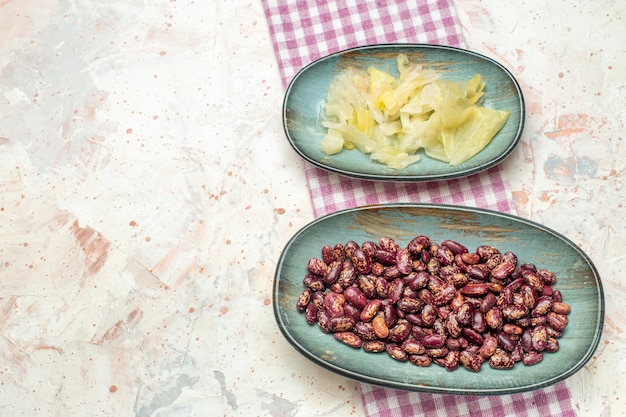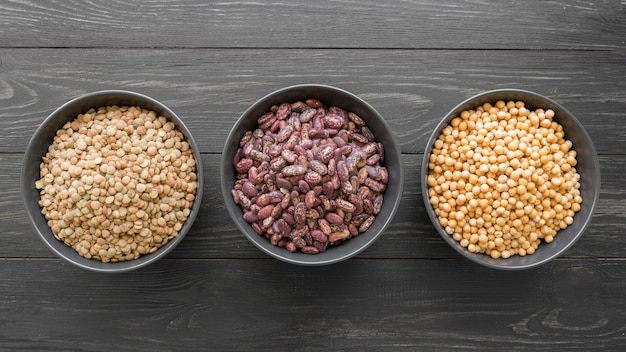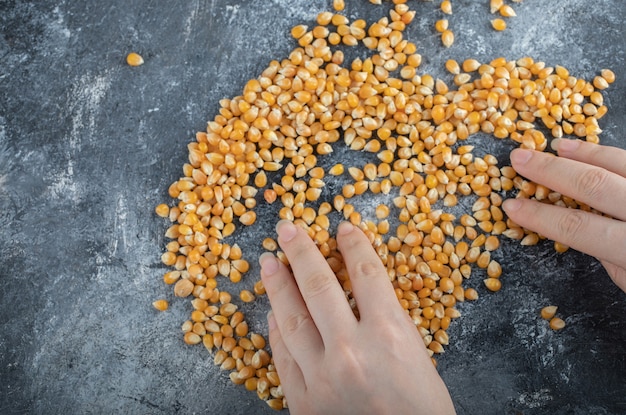Let’s face it, dried beans can seem a bit intimidating. All those soaking times, potential for mushy disasters, and those endless cooking instructions can make you just want to grab a can of pre-cooked beans instead. But trust me, the effort is worth it! There’s a world of flavour waiting to be unlocked in those humble dried beans, and once you master the basics, you’ll be whipping up delicious and satisfying dishes in no time. So grab your favourite bag of dried beans, settle in, and let’s embark on a journey from dry to delicious!
(Part 1) The First Steps: Choosing Your Beans

You wouldn’t bake a cake without the right ingredients, and the same goes for cooking beans. With so many varieties available, it’s important to choose the right bean for your dish. Some are better suited for salads, others for stews, and some are simply best enjoyed as a side dish. I’ll guide you through the options and help you select the perfect beans for your next culinary adventure.
What to Look For
Don’t just grab the first bag you see! When choosing your beans, look for a few key things:
- Freshness: Give the beans a good sniff. They should smell fresh, not musty or stale. A stale smell means they’ve been stored improperly and probably won’t taste their best.
- Appearance: Check the packaging. The beans should be free of debris, insects, or any other unwanted guests that might have decided to make a home in your bag.
- Variety: Think about what you’re making. Are you looking for a hearty stew? Then kidney beans or butter beans are your go-to choices. Want a lighter salad? black-eyed peas or chickpeas are perfect.
My Favourite Bean Picks
I’ve tried them all, and here are a few of my personal favourites:
- Kidney Beans: These are the classic for a reason – they hold their shape well, have a deep, rich flavour, and are perfect for chilli, salads, or even just a side dish with a sprinkle of salt and pepper. They add a satisfying texture and hearty flavour to any dish.
- Butter Beans: A bit more delicate than kidney beans, butter beans are utterly divine in stews and soups. They melt in your mouth and create a really creamy texture. Their delicate flavour blends beautifully with other ingredients, allowing their subtle sweetness to shine through.
- Black-Eyed Peas: These little gems are full of flavour and texture. They're great in salads, rice dishes, or as a side with a smoky barbecue sauce. Their subtle earthiness adds a unique dimension to any meal.
- Chickpeas: These are the ultimate versatile bean! From hummus to curries to falafel, chickpeas are a true superstar. Their mild flavour and creamy texture make them perfect for both savoury and sweet dishes, and their versatility is unparalleled.
- Lentils: These little guys are my go-to for quick and easy meals. They cook quickly, don't require soaking, and are incredibly flavourful. Plus, they're a great source of protein and fiber. I love using them in soups, stews, and salads.
(Part 2) The Soaking Saga: Preparing Your Beans for Success

Okay, now we’re getting into the real meat of it – soaking those beans. This is where many people get tripped up, but trust me, it’s not as complicated as it seems. Soaking helps to soften the beans, remove any grittiness, and reduce cooking time. Plus, it's a great way to prevent those pesky beans from exploding in your pot!
The Overnight Method
This is my go-to method, and the one I recommend for most beans. It’s simple and effective:
- Rinse: Give your beans a good rinse under cold water, making sure to remove any debris or loose beans.
- Soak: Place the rinsed beans in a large bowl and cover them with plenty of cold water, at least two inches above the beans. You want the beans to be completely submerged. Cover the bowl with a lid or cling film and pop it in the fridge overnight.
- Drain: The next morning, drain the soaking water. The beans will have absorbed water and plumped up beautifully, ready for cooking.
The overnight method allows the beans to soak slowly and evenly, resulting in perfectly cooked beans with a creamy texture and a delightful flavour. You can even add a pinch of salt to the soaking water to help season the beans.
Quick Soaking: When Time Is Tight
Sometimes, you just don't have the luxury of an overnight soak. No worries! You can quick soak your beans in boiling water for 1-2 hours. Just make sure to bring the water to a rolling boil before adding your beans. However, keep in mind that the beans won't be as soft as those soaked overnight, and they might require a slightly longer cooking time.
The No-Soaking Method (For Certain Beans Only)
For some beans, like lentils and mung beans, you can skip the soaking altogether. These beans have a thinner skin and cook faster than other varieties. But, be prepared for a slightly longer cooking time, as they'll need to soften while cooking.
(Part 3) The Cooking Process: Bringing Your Beans to Life

After soaking, it's time to bring those beans to life! Get your trusty pot ready, and let’s get cooking!
The Basics of bean cooking
Here’s the general formula for cooking your beans:
- Rinse: Give your soaked beans another good rinse under cold water to remove any debris or leftover soaking water.
- Pot It Up: Place the rinsed beans in a large pot. Add fresh water, making sure it's at least an inch above the beans. You want to ensure the beans are completely submerged in water.
- Add Flavor: This is where the fun begins! Add your favourite seasonings – onion, garlic, herbs, spices – whatever you fancy. I often throw in a bay leaf and some peppercorns for extra depth of flavour. Experiment with different combinations of spices and herbs to find your perfect flavour profile.
- Bring to a Boil: Bring the pot to a boil, then reduce the heat to a gentle simmer. You want to simmer the beans gently to prevent them from splitting or bursting.
- Simmer 'til Tender: The cooking time will vary depending on the bean type, but generally, you'll need to simmer them for 1-2 hours, or until they're tender but not mushy. You can test their tenderness by pressing a bean with a spoon. If it easily gives way, it’s ready.
- Taste and Adjust: After an hour or so, give your beans a taste and add more seasoning if needed. Remember, you can always add more, but you can't take it away! Seasoning should be done gradually, so you don’t over-salt your beans.
The Importance of Fresh Water
I always use fresh water for cooking my beans. It’s tempting to use the soaking water, but I find that it can sometimes make the beans a little too "earthy" in flavour. Fresh water provides a clean canvas for your beans to develop their natural flavour.
Don't Overcook!
The biggest mistake most people make is overcooking their beans. This can result in mushy, flavourless beans that are just not pleasant. So, make sure to check them regularly and stop cooking once they're tender but still hold their shape. You want them to have a slight bite, not a mushy texture.
(Part 4) The Finishing Touches: Enhancing Your Bean Dishes
Okay, your beans are cooked – well done! But, we’re not quite done yet. A few finishing touches can really take your bean dishes to the next level.
Adding Acid: The Secret Weapon
A splash of vinegar, lemon juice, or even a spoonful of tomato paste can do wonders for your beans. Acid helps to brighten the flavour and prevent the beans from becoming too mushy. It balances out the richness of the beans and adds a welcome tang.
Salt and Pepper: The Essential Duo
Don't forget to season your beans liberally with salt and pepper. You can even add a pinch of salt during the cooking process for extra flavour. Salt enhances the natural sweetness of the beans and helps to bring out their flavour.
Herbs and Spices: The Flavor Boosters
Get creative with your herbs and spices! Some of my favourites include thyme, rosemary, cumin, paprika, and coriander. Just be sure to add them towards the end of the cooking process to prevent them from losing their flavour. Herbs and spices add complexity and depth to your bean dishes.
(Part 5) bean storage: Keeping Your Beans Fresh and Ready to Use
You’ve gone to all the effort of cooking your beans, so you want to make sure they last! Here are a few tips for storing your cooked beans:
Refrigerator Storage: The Short-Term Solution
Cooked beans will keep in the refrigerator for up to 5 days. Simply store them in an airtight container filled with the cooking liquid. This helps to keep them moist and prevents them from drying out. You can also freeze them for longer storage.
Freezing for Longer Storage: The Longer-Term Solution
To freeze your cooked beans, simply transfer them to a freezer-safe container or bag and freeze for up to 3 months. When you're ready to use them, simply thaw them in the refrigerator overnight or in a microwave. Freezing your cooked beans allows you to enjoy their deliciousness for a longer period.
(Part 6) Beyond the Basics: Unleashing Your Culinary Creativity
Now that you've mastered the basics, it's time to get creative! Here are a few ideas for taking your bean cooking to the next level.
bean salads: A Light and Refreshing Option
Bean salads are a great way to enjoy your cooked beans. Simply toss them with your favourite veggies, herbs, and a light dressing. Some of my favourite salad combinations include:
- Mediterranean Bean Salad: Kidney beans, chickpeas, red onion, cucumber, feta cheese, olives, and a lemon vinaigrette.
- black bean salad: black beans, corn, red onion, bell pepper, cilantro, lime juice, and a dash of chili powder.
- Chickpea and quinoa salad: Chickpeas, quinoa, chopped celery, red onion, parsley, and a lemon-tahini dressing.
bean soups and Stews: Hearty and Comforting
For cold nights, there's nothing quite like a comforting bowl of bean soup or stew. Here are a few ideas to get you started:
- Classic Bean Soup: A simple but delicious soup made with kidney beans, carrots, celery, onions, and a ham bone.
- lentil soup: A hearty and flavourful soup made with lentils, carrots, celery, onions, and spices like cumin and coriander.
- White Bean and Sausage Stew: A satisfying and comforting stew made with white beans, italian sausage, onions, garlic, and tomatoes.
Bean Burgers and Meatless Meals: Creative and Delicious
Beans are a great base for meatless burgers, tacos, and other delicious dishes. Here are a few ideas:
- black bean burgers: Simply mash some black beans with breadcrumbs, onion, garlic, and spices, then form into patties and cook on the grill or in a pan.
- Chickpea Tacos: Make a delicious and filling taco filling with chickpeas, corn, bell peppers, onions, and a spicy tomato salsa.
- lentil loaf: A hearty and comforting loaf made with lentils, vegetables, and breadcrumbs.
(Part 7) Bean cooking tips and Tricks: Mastering the Art of Bean Cuisine
Now that you're well on your way to becoming a bean cooking expert, here are a few tips and tricks to make your life easier and your bean dishes even more delicious.
Use a pressure cooker: A Time-Saving Hack
If you have a pressure cooker, you can significantly reduce the cooking time for your beans. Just follow the manufacturer's instructions for cooking beans in your pressure cooker. Pressure cookers use steam to cook food quickly and efficiently, making them a great time-saver for busy cooks.
Use a slow cooker: For Hands-Off Cooking
Slow cookers are also a great option for cooking beans. Simply add your soaked beans, broth, and seasonings to the slow cooker and cook on low for 6-8 hours. Slow cookers allow the beans to simmer gently, resulting in tender, flavorful beans. You can add other ingredients, such as vegetables, herbs, and spices, to create a delicious and hearty stew.
Don't Be Afraid to Experiment: Discover New Flavours
Beans are incredibly versatile and pair well with a wide range of flavours. Experiment with different herbs, spices, and vegetables to discover your favourite bean dishes. Don’t be afraid to try new combinations and let your creativity run wild!
Enjoy the Process: Embrace the Bean Cooking Journey
Remember, cooking beans is a journey, not a race. Enjoy the process, be patient, and don't be afraid to get creative. You’ll soon be whipping up delicious and satisfying bean dishes in no time! Let the aromas fill your kitchen, and savor the anticipation of a delicious meal.
(Part 8) The Bean cooking faqs: Answering Your Burning Questions
You've got questions, I've got answers. Let's address some of the most common queries about cooking dehydrated beans:
Q: Why do my beans smell funny?
A: If your beans smell musty or stale, it's best to throw them away. This could indicate that they've been stored improperly or are past their best-by date. fresh beans should have a clean, earthy aroma. If they smell off, it’s better to err on the side of caution and discard them.
Q: What if I forget to soak my beans?
A: You can still cook your beans without soaking them, but it will take much longer. Add them to a pot with plenty of fresh water and simmer for 2-3 hours, or until tender. While soaking is recommended, it’s not essential. Just be prepared for a longer cooking time if you choose to skip it.
Q: Why are my beans mushy?
A: Overcooked beans are usually the culprit. Be sure to check them frequently and stop cooking once they're tender but still hold their shape. You want them to have a slight bite, not a mushy texture. The goal is to cook the beans until they are tender, but not to the point where they fall apart.
Q: Can I add salt to my beans during the cooking process?
A: Yes, but I recommend adding salt towards the end of the cooking process. Adding salt too early can make the beans tough. Salt helps to season the beans and enhance their flavour, but adding it too early can interfere with the softening process.
Q: What are the health benefits of eating beans?
A: Beans are packed with protein, fiber, and essential nutrients. They're a great source of iron, folate, and magnesium, and they can help lower cholesterol levels and regulate blood sugar. Beans are a nutritional powerhouse and a delicious way to enjoy a healthy and balanced diet.
So there you have it! Your complete guide to cooking dehydrated beans, from choosing the perfect bean to mastering the art of creating delicious bean dishes. Now go forth and cook! And remember, if you're ever stuck, just ask Google (or your mum!) for help. But I hope this guide has given you all the information you need to turn those dry beans into a culinary masterpiece. Happy bean cooking!
Everyone is watching

Prime Rib Roast Cooking Time Chart: Per Pound Guide
Cooking TipsPrime rib roast. Just the name conjures images of lavish dinners, crackling fires, and hearty laughter. It’s ...

How Long to Bake Potatoes in the Oven (Perfect Every Time)
Cooking TipsBaked potatoes are a staple in my kitchen. They're incredibly versatile, delicious, and surprisingly easy to m...

Perfect Rice Every Time: The Ultimate Guide to Cooking Rice
Cooking TipsAs a self-proclaimed foodie, I've always been a bit obsessed with rice. It's the foundation of countless cuisi...

The Ultimate Guide to Cooking Asparagus: Tips, Techniques, and Recipes
Cooking TipsAsparagus. The mere mention of this spring delicacy conjures up images of vibrant green spears, crisp and burs...

Ultimate Guide to Cooking the Perfect Thanksgiving Turkey
Cooking TipsThanksgiving. Just the word conjures up images of overflowing tables laden with delicious food, the scent of r...
